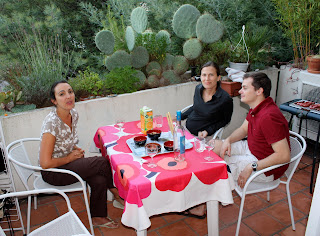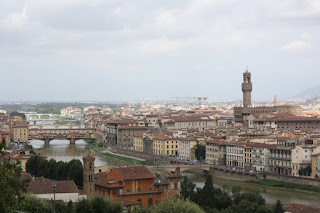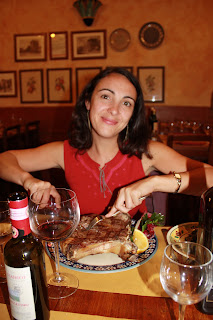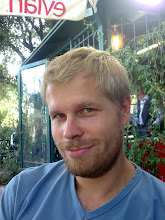
As we entered Umbria, we drove past Lake Trasimene, which is the fourth-largest lake in Italy. We figured it would make a good break before getting into Perugia. So we drove over to San Feliciano, a small fishing village (according to our guide book, didn’t look much like a fishing village to me), from where we took a boat over to the biggest island on the lake – Isola Polvese. We spent a couple of peaceful hours on the island, walking around, trying to stay away from the scorching sun. There’s nothing much to see on the island, apart from a ruined castle and a small church (which was shut). But it made for a nice break on the road. And the boat ride back to the mainland was pretty cool, we were treated to a very nice sunset over the lake.
The next major stop on the trip was Perugia, then. There was a very specific reason for this (apart from the fact that Perugia is supposed to be a very nice town) – Mathilde did her Erasmus here a few years ago. Our hotel was located about a 20 minutes’ walk from the town centre – by the time we arrived we didn’t really feel like a hike so we decided to dine at the hotel (not a bad choice at all, as it turned out).

On Saturday, we decided to visit Assisi. Assisi, is, of course, the birthplace of St. Francis, that humble chap who lived his life in poverty, and founded the Franciscan order while he was at it. After his honour, the powers that be decided to build a rather impressive basilica in his honor (St. Francis, humble as he was, might have thought it a bit excessive, perhaps?). This basilica is what makes Assisi the most popular tourists site in Umbria. We decided to start our visit by checking out the Eremo delle Carceri, the humble monastery located in a canyon above Assisi, where St. Francis used to retreat and preach to birds. The monastery was quite a peaceful place, and in a beautiful location indeed (we also came across what used to be St. Francis’ bed apparently, or rather the slab ot stone he slept on). Having done the tourist bit, we decided to hike up the mountain overlooking the monastery – Mount Subasio. It was quite a pleasant hike (aside the flies that just wouldn’t leave us alone), with nice views over Assisi and the surrounding countryside.

Having had our dose of exercise for the day, we headed down into Assisi, to check out the old town and that famous basilica. It’s a very nice old medieval town actually, with a very well preserved medieval centre, dotted with churches, one more impressive than the other (what I especially liked was an old Roman temple which had been converted into a church, on the main town square). It is of course rather a touristy place, but in spite of that we managed to find a nice little pizzeria for lunch. We then walked down to tackle the famous Basilica (Basilica Papale di San Francesco d'Assisi). It is the mother church of the Franciscan order, as well as the burial place of St. Francis. Which makes it one of THE pilgrimage sites in Italy. And it’s an undeniably impressive place. It’s actually divided into two levels, the upper and lower levels. We started at the well-lit upper levels, where we spent some time trying to decipher the beautiful frescos describing St. Francis’ life using our rather rubbish audio guide, and then continued down to the lower level, more dark, sober and atmospheric. And of course we made our way into the crypt as well, where St. Francis is buried. All in all, it’s a very impressive and spiritual place, and clearly an important place for a lot of people.

The rest of the day we spent exploring Perugia. And it surely didn’t disappoint, even after the rather overwhelming visits to Florence and Siena. It’s a very historic city, as it was one of the most important cities of Etruria (to simplify grossly, Etruscans are kind of the predecessors of the Romans). Some remains from this area can still be seen in the city, most notably one of the city gates in the old city. We naturally checked out Mathilde’s old haunts (including the famous Pazzetteria), and just strolled around this wonderful city. Perugia is not only blessed with a rather stunning old town, but is also brought to life by its large student population. This time of the year, there are loads of foreigners, thanks to Perugia’s international university. So actually Perugia had a very cosmopolitan, youthful and lively atmosphere, and didn’t feel touristy at all (which was quite refreshing after a week in Tuscany). I can definitely understand why Mathilde loved the months she spent here, lucky her… For dinner, we found a cozy little “typical Umbrian” eatery near the Duomo, where we spent a very nice evening…
For Sunday, the plan was to visit Orvieto. Orvieto is mostly known for its cathedral (oh, another one of those…), but also for its underground city and Etruscan remains. We started our visit by checking out the main Etruscan site of the city, the necropolis, located at the bottom of the imposing cliff upon which Orvieto is built (it’s quite a stunning sight, Orvieto, perched on its plateau). The necropolis wasn’t that much to write home about, actually, especially since the audio guide was “out of order indefinitely”.

After booking our tickets for the “Orvieto Underground” tour, we walked around town for a bit. It’s a typically pretty Italian town, but didn’t leave us as impressed as some of the towns we’ve seen so far during out trip. The cathedral is rather stunning, its imposing black/white exterior being quite similar to that of the Siena Duomo. The interior was impressive as well, but didn’t stand out from the other stunning cathedrals we’ve seen so far (we were definitely starting to suffer from a case of “Italian Cathedral Overdose”).
Orvieto underground, on the other had, was really cool. There is actually an extensive complex of tunnels, wells, caverns, stairs quarries, and god knows what, carved into the volcanic rock underneath the city. Some of those caverns are now open to the public (apparently the vast majority of the caverns are actually private property – and often used as cellars and storage space!). Some of the underground city was built during Etruscan times, other parts during the middle ages. Really fascinating stuff…

Having visited another Etruscan necropolis on the way back, we spent the evening walking around Perugia yet more. The more time we spent in Perugia, in fact, the more I liked it. The Duomo (which apparently houses the wedding ring of the Virgin Mary, no less), the Fontana Maggiore, the Corso Vanucci (the wide pedestrian street intersecting the old town, with its cafes, students and buzz), Via Aquedotto (a road built on top of an old aqueduct). Just great… For dinner, we picked a pizzeria, naturally one of Mathilde’s haunts during her student days. Delizioso!
On Monday, it was time to leave Perugia, sadly, and hit the road again… But before that, we had lunch booked with Antoine, a colleague of Mathilde’s who was staying near Perugia at his sister’s house (we already ran into another colleague of Mathilde’s on Saturday – seems to happen every time we go somewhere on holiday!). Before our rendez-vous, we decided on a bit of culture so visited Galleria Nazionale dell'Umbria (can’t really spend two weeks in Italy just eating and drinking wine, right? Gotta visit at least one art gallery…). Medieval and renaissance art isn’t really my cup of tea (which is what was mostly on display here), but it was pretty interesting seeing the way the painting style developed over the centuries (I’m not just writing that to fill in the blanks, honest!).

After this rather intensive dose of culture, we felt it was time for some food, so collected Antoine (and his young companion – daughter that is) and hunted down a nice, typical Umbrian restaurant. After a typically filling meal, washed down with some decent Umbrian red, we spent a leisurely afternoon walking around town, having a coffee, shopping at the local pasticceria, you know, the usual drill… After saying our bye byes to Antoine and his lady companion, it was time to carry on our journey…

The next stop was Gubbio, which promised to be yet another pretty medieval town. And pretty it is Gubbio, a cute little town built on the slopes of Mount Ingino. We didn’t have much time to explore town after checking into our hotel, as it was time to eat again. After a quick look on tripadvisor, we decided to go for the 2nd-ranked restaurant in town, a nice little Enoteca on the outskirts of the old town. An excellent choice, I must say! We arguably had our best meal so far during our holiday there (that’s saying something), treating ourselves to a large selection of local specialties (crostini, various hams, some sort of omelet, and other goodies), again washed down with some excellent wine. And at this point I have to make a special mention about the desert - 5 rather generous slices of different cakes for a couple of euros! Now that's good value for money! Pretty much the perfect start to our stay in Gubbio, I would say...

The next day, we got up bright ‘n early, since we were planning on doing another hike again (some would say we are crazy, considering the temperatures are on the steady rise – all the more reason to start early!). The hike took us through the very picturesque old town, up a pedestrian footpath all the way up to the top of the Mount Ingino (we could’ve cheated and taken the funicular, but we why do it the easy way when you can do it the hard way?). And that’s when the actual hike started. And a pleasant hike it was, I would say the best one we’d done so far. It was pretty even going (which was nice considering it was a wee bit hot), with varied terrain. And the views were great, at times stunning. The Umbrian landscapes are reminiscent of Tuscany, but more mountainous. All in all, the four-hour stroll was pretty good exercise.

The rest of the day we spent leisurely exploring Gubbio. There isn’t all that much to see, actually (especially since we were a bit fed up with churches for the moment, so didn’t walk into every one we came across), but Gubbio is pretty much the perfect little medieval town, very beautifully located on its mountain slope, and a great place to just stroll around, and soak in the atmosphere.
For the evening, we decided to go for the 1st-ranked restaurant on Tripadvisor – and naturally expectations were high. Unfortunately, this place didn’t quite live up to expectations. My menu gastronomic didn’t live up to its name (most of the stuff I had was pretty average), but at least it was good value for money. They even tried to cheat me out of one of my deserts! Oh well, you can’t always win.
The next day, it was time to leave Umbria, and carry on towards the Adriatic. Like Tuscany, Umbrian didn’t disappoint. There are perhaps less things to see than in Tuscany, but has the advantage of being a lot less plagued by tourists. And I could very much see myself studying Italian one summer in Perugia, who knows…? ;-)
 We didn’t get a lot of time to recover from our lovely holiday in Italy, until it was time to welcome some visitors. Sarah and Bruno, our dear friends from Paris, were stopping over for a night this time, on their way to Corsica for their holiday.
We didn’t get a lot of time to recover from our lovely holiday in Italy, until it was time to welcome some visitors. Sarah and Bruno, our dear friends from Paris, were stopping over for a night this time, on their way to Corsica for their holiday. 














































